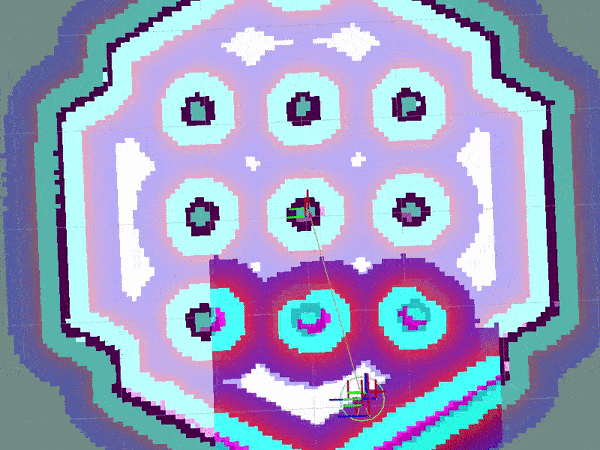编写新的控制器插件

概述
本教程介绍如何创建自己的控制器插件 plugin。
在本教程中,我们将根据这篇 论文 实现纯追踪路径跟踪算法。建议您阅读该论文。
注意:本教程基于现有的简化版本的Regulated Pure Pursuit控制器,该控制器现已包含在Nav2堆栈中。您可以在 这里 找到与本教程相匹配的源代码。
要求
ROS 2(二进制或源码编译)
Nav2(包括依赖项)
Gazebo
Turtlebot3
教程步骤
1- 创建一个新的控制器插件
我们将实现纯追踪控制器。本教程中的带注释代码可以在 navigation_tutorials 存储库的``nav2_pure_pursuit_controller``中找到。该软件包可被视为编写自己的控制器插件的参考。
我们的示例插件类 nav2_pure_pursuit_controller::PurePursuitController 继承自基类 nav2_core::Controller。基类提供了一组虚拟方法来实现控制器插件。这些方法在运行时由控制器服务器调用以计算速度命令。方法列表、描述和必要性如下表所示:
虚拟方法 |
方法描述 |
需要重写? |
configure() |
当控制器服务器进入on_configure状态时调用此方法。理想情况下,此方法应执行ROS参数的声明和控制器成员变量的初始化。此方法接收4个输入参数:父节点的弱指针、控制器名称、tf缓冲指针和costmap的共享指针。 |
是 |
activate() |
当控制器服务器进入“on_activate”状态时调用该方法。理想情况下,该方法应该实现在控制器进入活动状态之前必要的操作。 |
是 |
deactivate() |
当控制器服务器进入on_deactivate状态时调用此方法。理想情况下,此方法应实现在控制器进入非活动状态之前必要的操作。 |
是 |
cleanup() |
当控制器服务器进入“on_cleanup”状态时调用该方法。理想情况下,该方法应清理为控制器创建的资源。 |
是 |
setPlan() |
当全局路径更新时调用此方法。理想情况下,此方法应执行转换全局路径并存储的操作。 |
是 |
computeVelocityCommands() |
当控制器服务器要求提供新的速度指令以便机器人跟随全局路径时,调用此方法。该方法返回一个`geometry_msgs::msg::TwistStamped`,表示机器人的速度指令。该方法接受两个参数:当前机器人姿态的引用和当前速度。 |
是 |
setSpeedLimit() |
当需要限制机器人的最大线速度时调用此方法。速度限制可以用绝对值(m/s)或相对于最大机器人速度的百分比表示。请注意,通常情况下,最大旋转速度与最大线速度的变化成比例限制,以保持当前机器人行为不变。 |
是 |
在本教程中,我们将使用``PurePursuitController::configure``、``PurePursuitController::setPlan``和``PurePursuitController::computeVelocityCommands``这些方法。
在控制器中,`configure()`方法必须从ROS参数设置成员变量并执行所需的任何初始化。
void PurePursuitController::configure(
const rclcpp_lifecycle::LifecycleNode::WeakPtr & parent,
std::string name, std::shared_ptr<tf2_ros::Buffer> tf,
std::shared_ptr<nav2_costmap_2d::Costmap2DROS> costmap_ros)
{
node_ = parent;
auto node = node_.lock();
costmap_ros_ = costmap_ros;
tf_ = tf;
plugin_name_ = name;
logger_ = node->get_logger();
clock_ = node->get_clock();
declare_parameter_if_not_declared(
node, plugin_name_ + ".desired_linear_vel", rclcpp::ParameterValue(
0.2));
declare_parameter_if_not_declared(
node, plugin_name_ + ".lookahead_dist",
rclcpp::ParameterValue(0.4));
declare_parameter_if_not_declared(
node, plugin_name_ + ".max_angular_vel", rclcpp::ParameterValue(
1.0));
declare_parameter_if_not_declared(
node, plugin_name_ + ".transform_tolerance", rclcpp::ParameterValue(
0.1));
node->get_parameter(plugin_name_ + ".desired_linear_vel", desired_linear_vel_);
node->get_parameter(plugin_name_ + ".lookahead_dist", lookahead_dist_);
node->get_parameter(plugin_name_ + ".max_angular_vel", max_angular_vel_);
double transform_tolerance;
node->get_parameter(plugin_name_ + ".transform_tolerance", transform_tolerance);
transform_tolerance_ = rclcpp::Duration::from_seconds(transform_tolerance);
}
这里,plugin_name_ + ".desired_linear_vel"``获取了ROS参数``desired_linear_vel,该参数是特定于我们的控制器的。Nav2允许加载多个插件,并为了保持组织的有序,每个插件都映射到某个ID/名称。现在,如果我们想要检索该特定插件的参数,我们可以像上面的代码片段中所做的那样使用``<mapped_name_of_plugin>.<name_of_parameter>``。例如,我们的示例控制器映射到名称``FollowPath``,为了检索特定于“FollowPath”的``desired_linear_vel``参数,我们使用了``FollowPath.desired_linear_vel``。换句话说,``FollowPath``被用作插件特定参数的命名空间。在我们讨论参数文件(或参数文件)时,我们将会看到更多相关内容。
传入的参数被存储在成员变量中,以便在以后的阶段如果需要时使用。
在``setPlan()``方法中,我们接收到机器人要遵循的更新全局路径。在我们的示例中,我们将接收到的全局路径转换为机器人的坐标系,并将转换后的全局路径存储起来以供以后使用。
void PurePursuitController::setPlan(const nav_msgs::msg::Path & path)
{
// Transform global path into the robot's frame
global_plan_ = transformGlobalPlan(path);
}
期望速度的计算在`computeVelocityCommands()`方法中进行。它用于根据当前速度和姿态计算期望的速度指令。第三个参数是指向`nav2_core::GoalChecker`的指针,用于检查是否已达到目标。在我们的示例中,此参数不会被使用。对于纯追踪算法,该算法会计算使机器人尽可能紧密地跟随全局路径的速度指令。该算法假设线速度恒定,根据全局路径的曲率计算角速度。
geometry_msgs::msg::TwistStamped PurePursuitController::computeVelocityCommands(
const geometry_msgs::msg::PoseStamped & pose,
const geometry_msgs::msg::Twist & velocity,
nav2_core::GoalChecker * /*goal_checker*/)
{
// Find the first pose which is at a distance greater than the specified lookahead distance
auto goal_pose = std::find_if(
global_plan_.poses.begin(), global_plan_.poses.end(),
[&](const auto & global_plan_pose) {
return hypot(
global_plan_pose.pose.position.x,
global_plan_pose.pose.position.y) >= lookahead_dist_;
})->pose;
double linear_vel, angular_vel;
// If the goal pose is in front of the robot then compute the velocity using the pure pursuit algorithm
// else rotate with the max angular velocity until the goal pose is in front of the robot
if (goal_pose.position.x > 0) {
auto curvature = 2.0 * goal_pose.position.y /
(goal_pose.position.x * goal_pose.position.x + goal_pose.position.y * goal_pose.position.y);
linear_vel = desired_linear_vel_;
angular_vel = desired_linear_vel_ * curvature;
} else {
linear_vel = 0.0;
angular_vel = max_angular_vel_;
}
// Create and publish a TwistStamped message with the desired velocity
geometry_msgs::msg::TwistStamped cmd_vel;
cmd_vel.header.frame_id = pose.header.frame_id;
cmd_vel.header.stamp = clock_->now();
cmd_vel.twist.linear.x = linear_vel;
cmd_vel.twist.angular.z = max(
-1.0 * abs(max_angular_vel_), min(
angular_vel, abs(
max_angular_vel_)));
return cmd_vel;
}
剩余的方法没有使用,但是必须进行覆盖。根据规则,我们确实进行了覆盖,但是将它们保留为空白。
2- 导出控制器插件
现在,我们已经创建了自定义控制器,我们需要导出控制器插件,以便控制器服务器能够看到它们。插件是在运行时加载的,如果它们不可见,那么控制器服务器将无法加载它们。在ROS 2中,导出和加载插件由``pluginlib``处理。
回到我们的教程,类 nav2_pure_pursuit_controller::PurePursuitController 动态加载为 nav2_core::Controller,这是我们的基类。
要导出控制器,我们需要提供两行代码。
#include "pluginlib/class_list_macros.hpp"
PLUGINLIB_EXPORT_CLASS(nav2_pure_pursuit_controller::PurePursuitController, nav2_core::Controller)
请注意,它需要 pluginlib 来导出插件的类。Pluginlib 将提供宏 PLUGINLIB_EXPORT_CLASS,该宏执行所有导出的工作。
将这些行代码放在文件末尾是一个好的做法,但从技术上讲,你也可以写在文件顶部。
下一步是在软件包的根目录中创建插件的描述文件。例如,在我们的教程软件包中创建一个名为
pure_pursuit_controller_plugin.xml的文件。此文件包含以下信息:
library path:插件的库名称及其位置。class name:类的名称。class type:类的类型。base class:基类的名称。description:插件的描述。
<library path="nav2_pure_pursuit_controller">
<class type="nav2_pure_pursuit_controller::PurePursuitController" base_class_type="nav2_core::Controller">
<description>
This is pure pursuit controller
</description>
</class>
</library>
下一步是使用
CMakeLists.txt导出插件,使用 CMake 函数pluginlib_export_plugin_description_file()。此函数将插件描述文件安装到share目录,并设置 ament 索引以使其可被发现。
pluginlib_export_plugin_description_file(nav2_core pure_pursuit_controller_plugin.xml)
插件描述文件也应添加到``package.xml``中。
<export>
<build_type>ament_cmake</build_type>
<nav2_core plugin="${prefix}/pure_pursuit_controller_plugin.xml" />
</export>
编译后,应该进行注册。接下来,我们将使用此插件。
3- 通过参数文件传递插件名称
要启用插件,我们需要修改 nav2_params.yaml 文件如下所示:
controller_server:
ros__parameters:
controller_plugins: ["FollowPath"]
FollowPath:
plugin: "nav2_pure_pursuit_controller::PurePursuitController"
debug_trajectory_details: True
desired_linear_vel: 0.2
lookahead_dist: 0.4
max_angular_vel: 1.0
transform_tolerance: 1.0
在上面的代码片段中,您可以观察到我们将 nav2_pure_pursuit_controller/PurePursuitController 控制器映射到其 ID FollowPath。要传递特定于插件的参数,我们使用了 <plugin_id>.<plugin_specific_parameter>。
4- 运行 Pure Pursuit Controller 插件。
使用启用的 Nav2 运行 Turtlebot3 模拟。有关如何运行的详细说明,请参阅 开始使用。下面是一个快捷命令:
$ ros2 launch nav2_bringup tb3_simulation_launch.py params_file:=/path/to/your_params_file.yaml
然后进入RViz,并点击顶部的"2D Pose Estimate"按钮,在地图上指定位置,就像在 开始使用 中描述的那样。机器人将在地图上进行定位,然后点击"Nav2 goal",并在您希望机器人导航到的姿态上点击。之后,控制器将使机器人沿着全局路径移动。